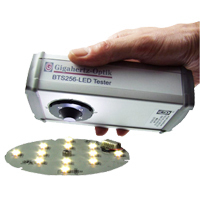Jun 18 2010
The hand-held BTS256-LED tester from Gigahertz-Optik (GO) is able to measure spectral distribution, illuminance and color data of discrete LEDs placed in a module, that form part of a narrow beam transmitting source of light, miniature lamps, and those mounted on a PC board. It is possible to measure larger sources of light by utilizing the screw-on diffuser window or attaching the Gigahertz-Optik integrating sphere to the BTS256-LED tester.
The tester’s main components include a distinctive input optic nozzle that minimizes positional error, an in-built integrating sphere of 50mm diameter, GO Bi-Tech sensor, and an auxiliary LED.
 Gigahertz-Optik's BTS256-LED Tester
Gigahertz-Optik's BTS256-LED Tester
The integrating sphere incorporates a light output port of the sealed window type. It is made using the white diffuse material of GO.
The light sensor houses a low stray light, compact design spectrometer, and a precise photometric filtered photodiode to detect the flux accurately over a broad dynamic range.
It also features the highly compact electronically controlled shutter that is used for affecting the diode array’s on-line offset compensation for enhanced signal to noise levels.
A test bench used to measure LEDs can create varying color and photometric results as compared to the values obtained of these LEDs when they are mounted on the PC board. Also it is not possible to measure slight flux and color variations between discrete LEDs incorporated in a module using customary LED measurement set-ups.
This device measures and displays color rendering index, peak wavelength, u'v' and xy color coordinates, dominant wavelength, and color temperature.
The spectral data measured is also utilized for used for the photometric detector’s on-line correction of error relating to the photopic spectral mismatch.
To compensate for the absorbance errors in the test sample, the device has a white LED auxiliary lamp. The PC based calibration correction, LED tester, auxiliary lamp function and various input nozzles of different sizes are controlled by supplied G.O.O.S. software.